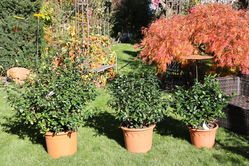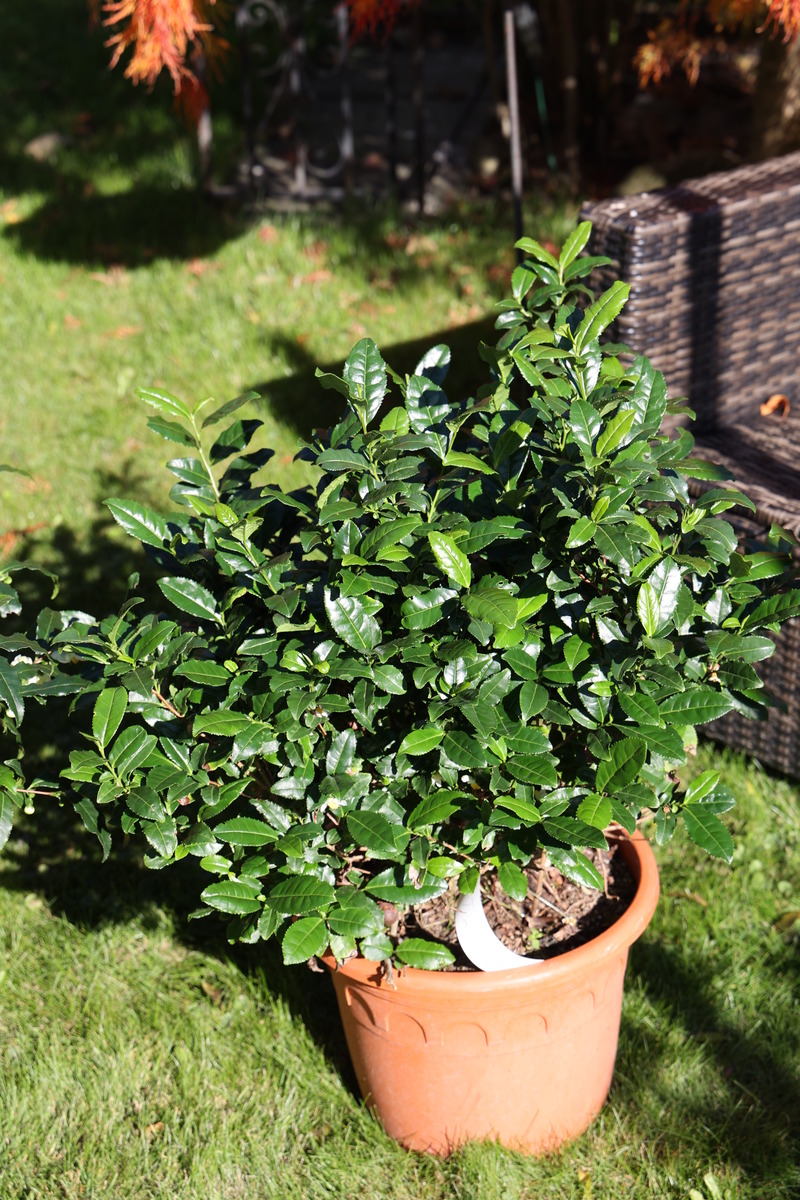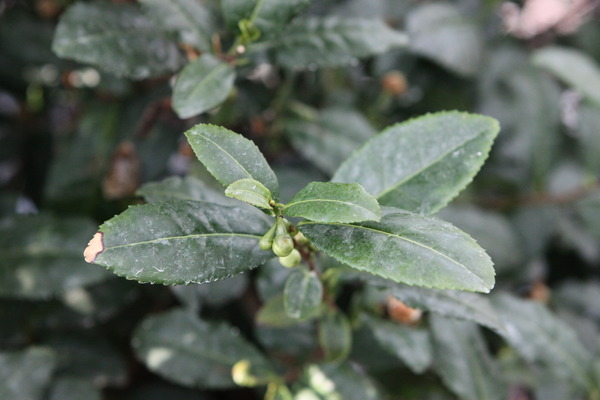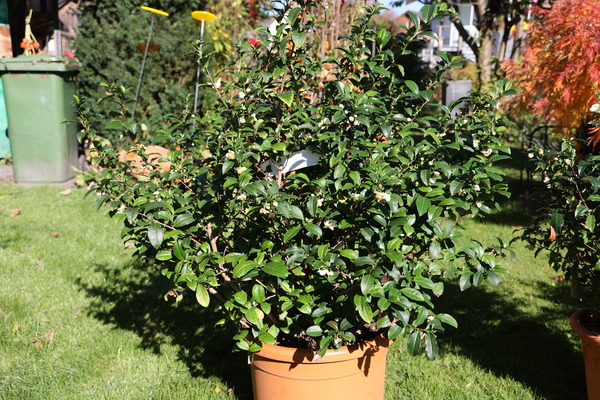 Lubera Edibles now offers three different tea plant varieties (Camellia sinensis) as young plants. Can tea be cultivated and produced in Central Europe? What conditions need to be considered? How hardy are the new Fresh-T varieties? We try to answer these questions in the following article.
Lubera Edibles now offers three different tea plant varieties (Camellia sinensis) as young plants. Can tea be cultivated and produced in Central Europe? What conditions need to be considered? How hardy are the new Fresh-T varieties? We try to answer these questions in the following article.
Origin of the Fresh-T® varieties
We have selected our Fresh-T® varieties from a population that originates from the cool, hilly area of South Korea. In our tests, these origins performed better than comparable populations from Russia, mostly from the Crimea. Over 10 years, we then selected the best varieties with the most interesting growth characteristics, the best winter hardiness and the easiest to use from over a thousand South Korean seedlings. The selection took place at our Lubera sister company in Bad Zwischenahn in northern Germany.
Fresh-T® variety portraits
Our three new Camellia sinensis varieties differ in growth and also in the resulting possible uses.
Camellia sinensis Fresh-T® Teabux®

Teabux® has the most upright and at the same time most compact growth and is perfect for creating small tea hedges:
- Approx. 40-60 cm high after five years and with regular harvesting
- Few side shoots, upright growth
- The leaves are pointed and serrated and have the strongest shine
- Few flowers in autumn
- Winter hardiness from -12°C to -15°C
- Use for the production of green fresh tea
- Grow and cultivate in acidic soil (blueberry soil)
- Leave to grow freely for two to three years, then cut back to a "table" each year in the spring by cutting back all of the new shoots to approx. 20% of their total length
- The new shoots then develop on this table, which can be harvested continuously in the spring - harvest the first and second flush by approx. mid-May, then leave to grow
Camellia sinensis Fresh-T® Tearoma®

The Camellia sinensis variety Tearoma® has the most intense black tea and green tea flavour of all the varieties.
- 70-100 cm tall after five years and regular harvesting
- Broad-growing, ideal as a single plant or in small groups of three to five bushes at a distance of 50 cm, giving the appearance of ONE large tea bush over time
- Strikingly furrowed leaves
- Produces good flowers in autumn, which can also be used for tea
- Most intense black tea flavour of all varieties, for all types of tea preparation
- Winter hardiness from -12°C to -15°C
- Use for fresh tea, flower tea and matcha tea
- Grow and cultivate in acidic soil (blueberry soil)
- Pruning: leave to grow for the first three years, then cut the entire plant down to a flat 'tea table' in the spring (February) by reducing all of this year's shoots to approx. 20%
- Harvesting: in the spring; if possible, only harvest the first flush of new shoots in March/April, then allow the plant to grow so that there are still enough flowers on the freshly grown shoots
Camellia sinensis Fresh-T® Bloomtea®

The Bloomtea® variety forms the broadest and largest shrubs and blooms the most of all varieties in autumn/winter. Bloomtea® can or should therefore be grown freely (almost) without pruning and instead of focusing on the fresh shoot tips in the spring, the tea lover concentrates on harvesting the blossoms for flower tea in autumn.
- After five years, Bloomtea® grows to a height of approx. 100-130 cm
- Broad and strong-growing; as single plants or in containers, plant three plants 70 cm apart for group plantings
- The leaves are slightly more oval and rounder than the other varieties
- Pruning: if other varieties are usually cut back to a uniform height in the spring to form an easily harvestable tea table with as many fresh shoots as possible, the Bloomtea® variety can be left to grow relatively freely and will then form the largest Fresh-T® bushes. If necessary, the tea plant can be pruned back a little in February; from time to time, old, woody branches can also be diverted to young side branches that are as low as possible to rejuvenate the bush
- The strongest flowering is in autumn starting in September
- Use for fresh leaf tea and especially for flower tea
- Winter hardiness from -12°C to -15°C
- Grow and cultivate in acidic soil
How hardy are Fresh-T® varieties?
The Camellia sinensis varieties from Lubera Edibles can withstand -12°C to -15°C for short periods (days and weeks, but not months) when planted out. In Bad Zwischenahn in northern Germany, we cultivate these tea plant varieties as planted shrubs in the open field; in the winter we throw a shade net over them at very low temperatures because they are unshaded. In the garden, Fresh-T® shrubs can also be grown outdoors in northern Germany and other parts of Germany, Austria and Switzerland in mild locations (radiation from a wall or house). In cooler locations, they can be grown as container plants. The most important thing when choosing a location, apart from a mild climate without severe winter lows, is that the tea plants are shaded or semi-shaded. This is where they sprout most evenly and with the finest tea flavour in the spring, and where there is no leaf burn from the strong winter sun (and possibly frozen ground at the same time).
To be on the safe side: tea plants should always be placed in partial shade or shade!
The production of Camellia sinensis plants - with young plants from Lubera Edibles
Camellia sinensis generally grows rather slowly - and of course, the tea plants need acidic soil (the same requirements as blueberries). We recommend growing the tea plants in plastic tunnels or in a greenhouse. The production of both small, compact young tea plants in 9 cm to 13 cm pots and larger container plants takes almost exactly 12-14 months each.
Production of 9 cm to 13 cm pots
- Pot Lubera Edibles young plants in March to May
- Light pruning around the longest day
- Overwinter in a plastic tunnel
- Remove the tops of the plants in February to encourage fresh shoots
- Sales starting in April or May of the following year
Production of plants in 3-5 litre pots
- Pot in 9 to 13 cm pots (see above) in February to April
- Prune back by 30-50 % after potting and before starting cultivation
- If growth is good and strong, prune back slightly around the longest day to encourage branching
- Cool overwintering should take place in a plastic tunnel or greenhouse at +2°C
- Remove the tops of the plants in February to encourage fresh shoots
- Sales starting in April or May of the following year
The most important growing tips for Fresh-T® in the garden
As is always the case with plants with limited hardiness, to which the new tea varieties can be categorised, they can be grown both in the garden and in containers. Of course, it is important to ensure that Camellia sinensis grows in acidic soil. If this is not available in the garden, the tea plants must be cultivated either in a bog bed or in a pot/container with bog soil.
Cultivation in the garden
- Plant deep so that the plant can regenerate from the base after a very cold winter
- Mild microclimate, radiation from walls or houses
- The most important thing is this: a semi-shady or shady location all year round; in full sun, the evergreen leaves evaporate too much water on a sunny winter's day, which cannot be replenished by the roots
- If necessary, protect with a fleece during the coldest winter phases or, better still, with a shade net
- Camellia sinensis is an evergreen plant, so it needs light and cannot be kept in a lightproof winter shelter all winter
Cultivation in a container
- Choose a 10-15 litre pot
- In a pot, the winter location can be chosen freely, somewhere on the north side of the house in a sheltered corner; overwintering in a cold tunnel or greenhouse is possible, or also in a bright garage
- Starting in the spring is better if the winter temperatures can be kept as cool as possible at 2°C to 10°C
